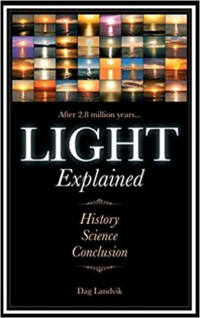Title: Light Explained: History, Science, Conclusion
Author: Dag Landvik
Publisher: Virtualbookworm.com Publishing
ISBN: 1949756378
Pages: 138
Genre: Physics
Reviewed by: David Allen
Pacific Book Review
Light Explained: History, Science, Conclusion reads like a symphonic tribute to the history and progress of science. This slim volume is a feast of discovery, touching upon the great achievements of scientific and philosophical thought from ancient Greece up to our own time.
The author is clearly at home with the subject and clearly impassioned by it. The fervor and enthusiasm of the writing is contagious. Readers of all levels of scientific sophistication will find these pages to be informative, thought-provoking and downright inspirational.
All of this fervor is marshalled in the book’s stated mission: to explain light. It turns out that the quest to find theories and science adequate to the task have been with us since the ancient Egyptians and since great thinkers like Plato, Socrates, Pythagoras, and Aristotle. According to the author, “Being enlightened is an experience of knowledge.”
One major controversy throughout the history of science has been the debate over the true nature of light: is light a particle, a wave, or is it both? Landvik offers a challenging proposition, namely, that light as we see it does not actually exist in space, but instead results from the incredible interplay of perception and electromagnetic waves. This theme is taken up repeatedly in the book, and parallels other intriguing debates in cognitive science. Consciousness itself, it has been argued elsewhere, may be an ‘epiphenomenon’ or artifact of the process of perception itself.
The book’s dance about the May pole of subject vs. observer is skillfully paralleled in the formatting and content of its narrative. Chapters are headed by profoundly moving photographs of sunset light upon water, and the didactic impetus of the book is boosted by the paragraph and subsection headings that facilitate access to this orb of knowledge.
Dag Landvik is an inventor with an international presence, and belongs to the Society for Physical Research (London.) Heisenberg’s uncertainty principle–that the measurement of physical phenomena is always affected (if not confounded) by the presence of an observer–informs the author’s views throughout. This is a good thing, because Landvik’s ultimate portrait of the universe as a dynamic interplay between living perceiving beings and ‘physical’ phenomena like electromagnetic waves is lovely, intriguing, and important.
On his deathbed, the great German writer Goethe is reported to have said, ‘More light.’ This injunction is heroically and convincingly honored in Landvik’s book.


